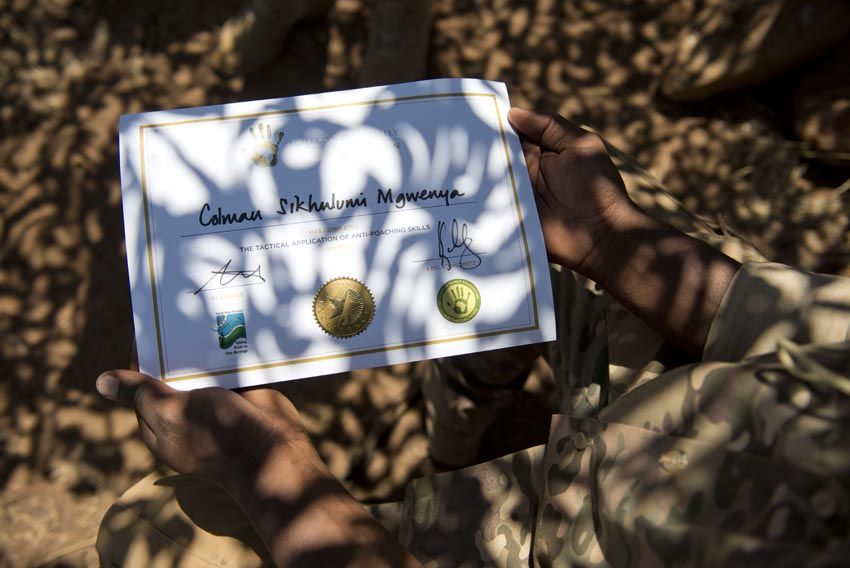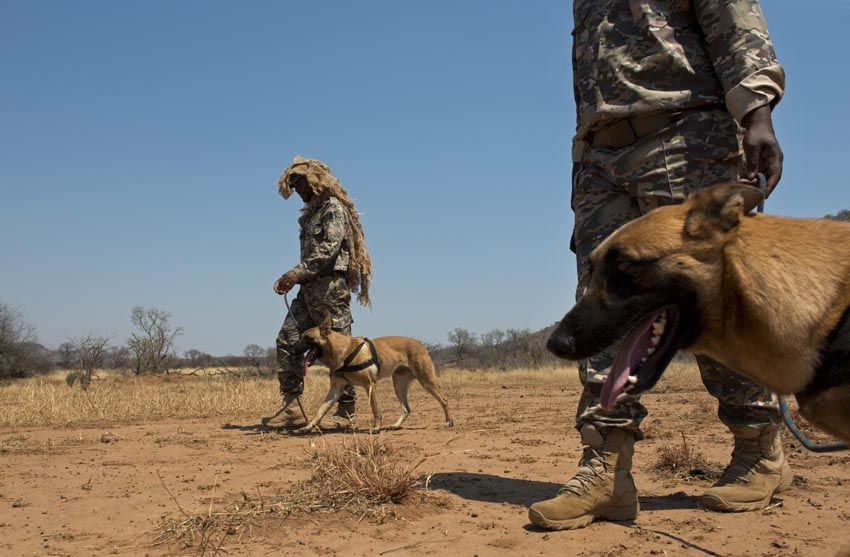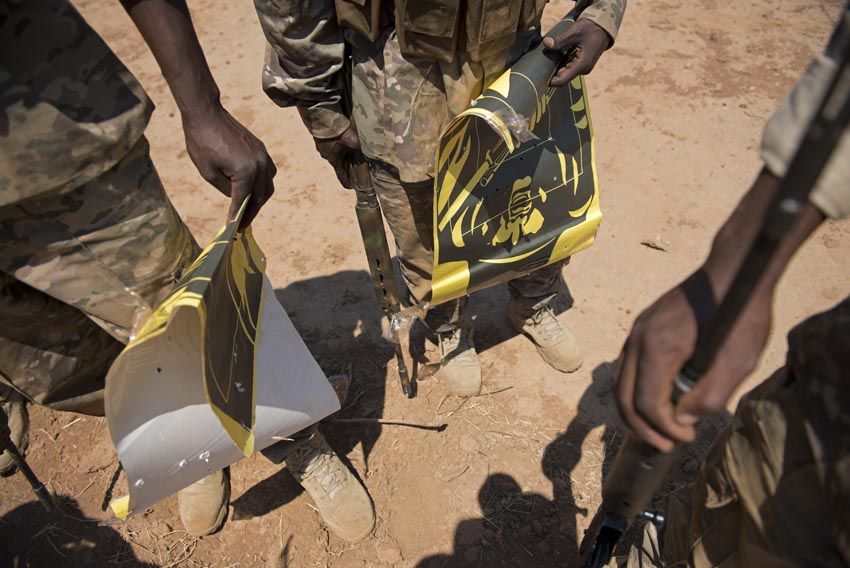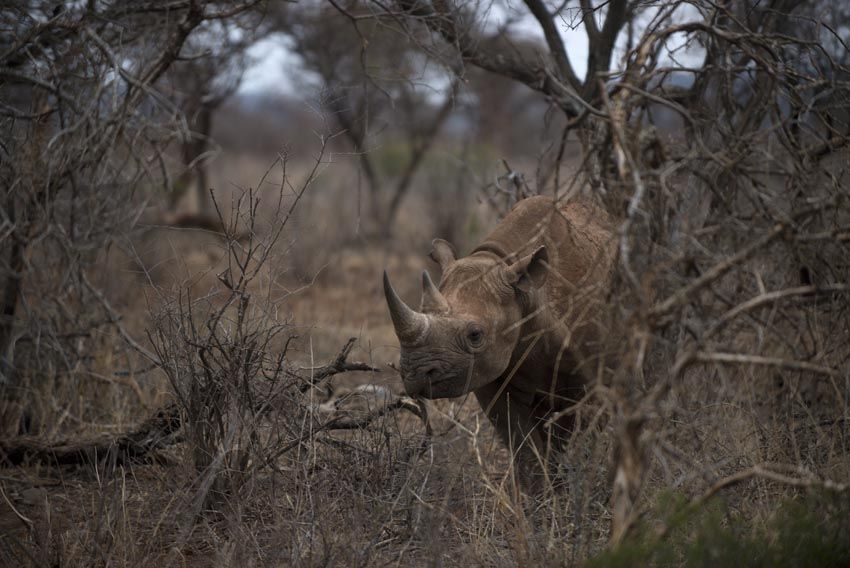Two black rhino are pulling the new, spring leaves off a thicket of bushes in Madikwe Game Reserve in the North West. The sound of their teeth grinding the sustenance is occasionally tempered by rolling thunder in the distance. Their dark grey hides blend into the brush, but their massive bulk and the scarcity of thick trees means they still stand out. This makes them sitting targets for poachers – their ears might be constantly rotating for any sound, but their vision is very poor. At best, they can hear something 50m away.
But they are alive, and so are many other rhino thanks to the training being given to the reserve's rangers and anti-poaching teams. In the past, the rangers were poorly equipped and could not hit a target at 25m. Now they can hit one at more than 600m. They are also better equipped and trained to react calmly when in a firefight – even with their shooting ability, most contacts happen at 60m because the bush offers hiding places, making the interactions sudden.
"The bush grapevine has been working and the poachers now know if they get into a fight with these guys they are in a proper scrap," says Alan Ives. A former British army soldier, he has been putting the rangers through a rigorous course to get them on a level footing with poachers.
When he first arrived four months ago, the reserve was losing rhino every week, and the rate was accelerating. The rangers had undergone quick courses on how to shoot and do field-craft, and were then sent into a bush war. They had minimal ammunition and poachers would often engage in a fight at ranges more than 600m far, making them use their ammunition and retreat.

Ives has concentrated on the things rangers don't normally get trained to do, such as how to survive stress. "In a fight, your first reaction comes with a spike in adrenaline. This impairs how well you fight." His exercises put rangers under duress, and then gets them to think and operate normally. "This means when they get into contact, they know what to do and are much calmer."
The training has given the rangers confidence, and they all smile and talk with some bravado about their new skills. But the wild is still the wild and walking in thick bush leads to all sorts of contact. Park ranger Elvis Manganye laughs as he describes the few times he has been charged by rhino and elephants. "They are big so the first time, you fear them. But they also do not turn well, so you can run and go sideways to get behind them. Then you are safe."
His home is near Pafuri Gate at the very top of the Kruger National Park, but he went to Mpumalanga to work with the anti-poaching units. "We have to look after our animals. They are our national pride and people are killing them for nothing. If it means we must fight people to stop that, we have to." His black R1 rifle gleams from the cleaning and oiling. It is also the heaviest piece of his kit – on an operation they can be in the bush for two weeks, but things like water and food are resupplied covertly during that time.
No soft target
Declan Hofmeyer has lived and worked in the reserve for 15 years, and is now in charge. A camouflage kit and rifle sit in the cab all the time, and a pistol sits strapped to his hip. To illustrate the volume of poaching, he flips through dozens of pictures of dead rhino. "This is the one that broke me." He shows a calf rhino that he saved, and then a picture of her corpse. "They didn't even get a horn. She died for absolutely nothing." His sentences contain a quiet anger.

This drove him to look for more help, and do anything he could to get more support for the rangers working in the reserve. The training is just in time. Where in the past poachers were coming with rifles and basic weapons, now they are coming heavily armed. They are also coming from different parts of the continent. "We have seen professional crews from Mozambique and that is really worrying." The intensification of antipoaching efforts in the Kruger National Park means poachers are looking for softer targets, like Madikwe. "We will not be a soft target," he says.
Before the training and the start of Operation Baseline – a reference to the need to return poaching levels to a baseline – Madikwe has the highest levels of poaching for anywhere except Kruger. There have been no killings in nearly three months. Such phrases are always followed by the utterer looking for the nearest piece of wood to touch. Always.
The last part of the year is traditionally the worst – on any graph of poaching numbers there is a tremendous spike in the last quarter of the year, and nobody knows why. But it then drops off at the end of the year. "We find that most of the poachers go home for Christmas," says Hofmeyr.
1 000 rhino could die this year
This year is no different. Initial projections were that around 700 rhino would be poached in South Africa this year. Last year, 668 were killed for their horns. That number was passed with 100 days to go, and now the number could be 1 000.

Many of the members of the specialised antipoaching unit, which works alongside the rangers and honorary rangers, are recent additions to the reserve, having come from other operations. Coleman Ngwenya first trained to fight poachers while working in Mpumalanga. A local of the province, he wanted to protect animals. "The first time I saw a rhino was on television. It looked so small, so I was shocked when I saw one in the bush. They are so big!"
Besides the poachers, there is a day-to-day risk with living in the bush. Ngwenya's friend was attacked by a lion while on patrol. "We are told the best thing to do with a lion is to stand straight, because then it is confused. If you run you are prey and you cannot outrun a lion." But it is still poachers that worry him the most. He has not had a contact yet and after all his training, is itching to go. "We are ready."
In the bush, their worst times are full moons – "killing moon" – and in the hours before dawn when things are at their darkest. With a few large hills and mostly flat bush, the rangers have now started setting up observation posts on the highest points. These allow them to observe dozens of square kilometres of the reserve at once. Two rangers occupy one of posts and guide teams towards any poachers they see. The posts are well camouflaged and use all the tricks of field-craft, such as using a tree's shadow for cover because it does not reflect anything.
"This is how we're going to win this fight. You tell a poacher that the stakes are that much higher, and he'll begin to question what he is doing," says Ives.

Images by Paul Botes, M&G
This trip was organised by the Ichikowitz Family Foundation, which is supporting Operation Baseline.